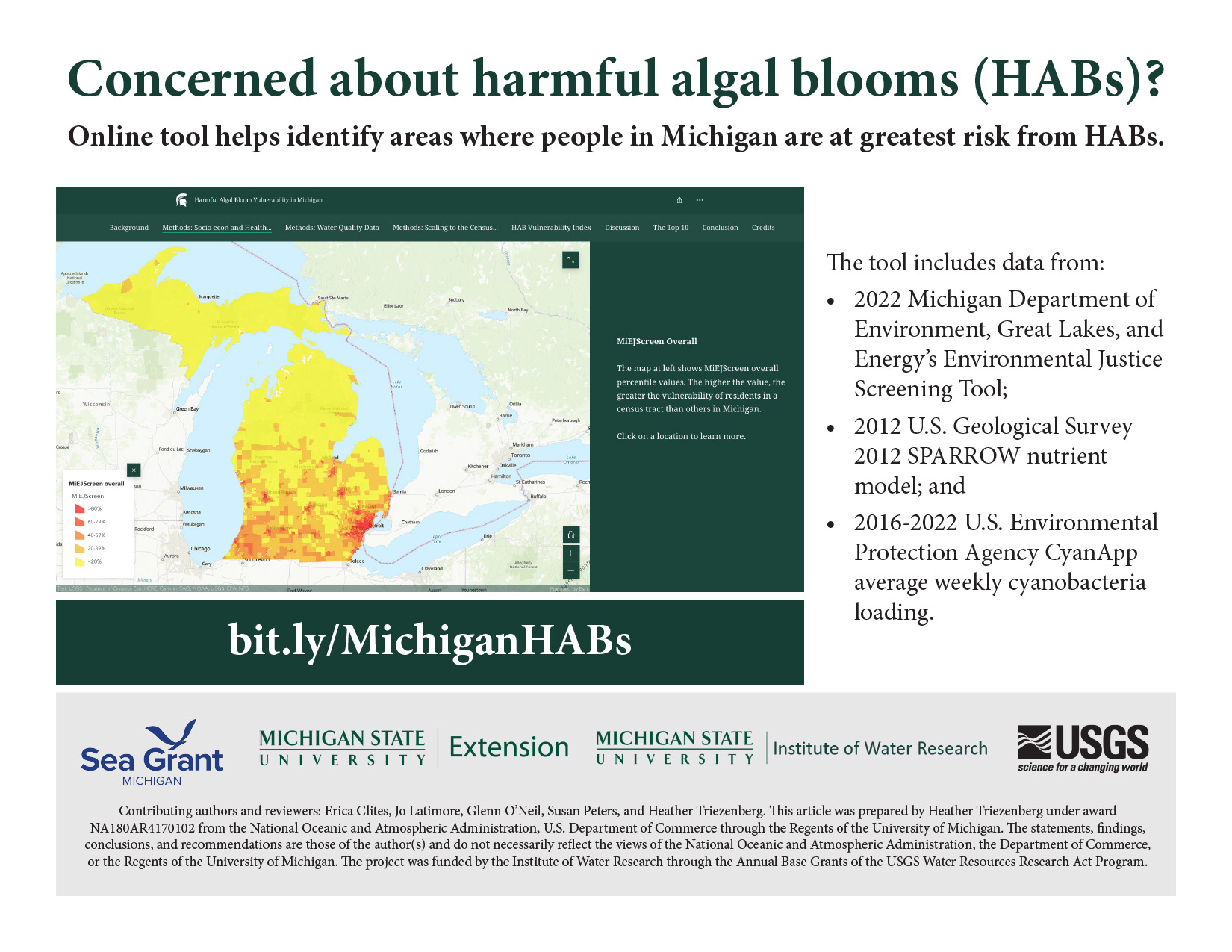Online tool identifies areas where people in Michigan are at greatest risk from harmful algal blooms (HABs)
Some algal blooms contain toxins that can be harmful to animals or humans.

Algae are tiny, microscopic plants or cyanobacteria that live in most waterbodies, and when they grow to a size that can be seen, this is called an algal bloom. Some algal blooms contain toxins that can be harmful to animals or humans. When that occurs, it is called a harmful algal bloom or HAB. Michigan State University (MSU) Institute of Water Research, MSU Extension, and Michigan Sea Grant developed a tool (https://bit.ly/MichiganHABs) to identify locations where HABs in Michigan may pose the greatest risk to humans. 
Many factors can influence the occurrence of HABs, including land uses and nutrients entering a waterbody. Some people, such as children 5 years and younger or adults 65 years and older, or people with asthma, other underlying health conditions, or a weakened immune system may be more sensitive to the risks of HABs. Therefore, the tool spatially displays:
- Socioeconomic and health data from the 2022 Michigan Department of Environment, Great Lakes, and Energy’s Environmental Justice Screening Tool;
- Watershed scale simulated nutrient loading of total phosphorus and nitrogen from the U.S. Geological Survey 2012 SPARROW model; and
- Average weekly cyanobacteria loading recorded between April 2016 and July 2022 by the U.S. Environmental Protection Agency’s CyanApp.
Across the state, it is estimated there are approximately 2,700 census tracts (of varying size) with some risk of HABs to humans. Check out the website to learn more about your area. Explore each of the data sources individually or scroll to the Top 10 tab to see specific locations. The top 10 census tracts with greatest HABs risk to humans are listed below along with the factor contributing most to the risk at that location.
|
Rank |
Location |
Major risk factors |
|||
|
|
|
high cyano-bacteria loads |
high percentage of children <5 years |
high asthma likelihood |
high nutrient loads from wastewater treatment |
|
1 |
North bank of mouth of River Raisin by Lake Erie |
X |
|
|
|
|
2. |
South bank of mouth of River Raisin by Lake Erie |
X |
|
|
|
|
3. |
South bank of St. Joseph River near Three Rivers |
X |
X |
X |
X |
|
4. |
North bank of St. Joseph River near Three Rivers |
X |
X |
X |
X |
|
5. |
Ypsilanti near Ford Lake |
X |
X |
|
|
|
6. |
Port Huron in between Black River and St. Clair River |
|
X |
|
X |
|
7. |
Van Buren near Belleville Lake |
X |
|
|
X |
|
8. |
Dearborn along the Rouge River |
|
X |
|
X |
|
9. |
Bay City near the Saginaw River |
|
X |
X |
X |
|
10. |
Detroit near the Rouge River and Detroit River |
|
X |
X |
|
To learn more about HABs in Michigan, visit Michigan Department of Environment, Great Lakes, and Energy‘s HABs website.
Michigan Sea Grant helps to foster economic growth and protect Michigan’s coastal, Great Lakes resources through education, research and outreach. A collaborative effort of the University of Michigan and Michigan State University and its MSU Extension, Michigan Sea Grant is part of the NOAA-National Sea Grant network of 34 university-based programs.
This article was prepared by Heather Triezenberg under award NA180AR4170102 from the National Oceanic and Atmospheric Administration, U.S. Department of Commerce through the Regents of the University of Michigan. The statements, findings, conclusions, and recommendations are those of the author(s) and do not necessarily reflect the views of the National Oceanic and Atmospheric Administration, the Department of Commerce, or the Regents of the University of Michigan. The project was funded by the Institute of Water Research through the Annual Base Grants of the USGS Water Resources Research Act Program. Contributing authors and reviewers: Erica Clites, Jo Latimore, Glenn O’Neil, Susan Peters, and Heather Triezenberg.



 Print
Print Email
Email




